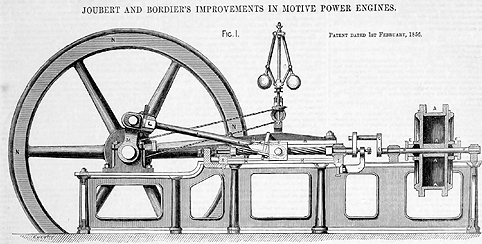In September 1856 the editors of The Engineer appeared to take a certain degree of pleasure in deriding the efforts of two French engineers who earlier in the year had patented what they believed to be improvements to motive power engines.
Maybe The Engineer was too preoccupied with reporting on the Bessemer Process or Cullen Whipple’s screw machine to take Messrs Charles Catherine Joubert and Leon Andre Bordier’s polydyname seriously?
Either way, as the opening paragraph to the following abridged item shows, their efforts are thought of as nothing more than fanciful indulgance but they are at least afforded the respect of a full review of the mechanical workings of their patented system
Enough of the preamble and onto This week in September 1856: Jourbert and Bourdier’s improvements in motive power engines.

‘We have illustrated this invention for the purpose of showing the extraordinary fancies in which French mechanicians indulge.
‘The engine which the inventors designate by the name of polydyname, consists in the application of a screw to a driving shaft for transmitting motion, so as to multiply the power of action.
‘Various means may be used for attaining this result: the mode shown in the accompanying illustrations consists of a multiplex thread screw forming the extension a shaft, upon which a piston paddle is keyed; this is intended to work into a cylinder, having two openings for admitting, and one opening for emitting steam, and which is also provided with a fixed inside partition.
‘When the steam is let through such an arrangement it presses against the fixed partition, acting at the same time upon the paddle or piston paddle connected with the shaft, which is thus carried in a circular motion.
‘Upon the piston reaching the opposite side of the fixed partition the steam escapes; after having exerted its action, another current of steam is let in through the other side of the partition, which drives the piston back to its former position.
‘To the piston is thus imparted continuously an alternate circular motion; and, therefore, in consequence of the screw being in connexion with the cylinder shaft, it is likewise carried into a similar alternate circular motion, by which a nut or female screw is actuated, being joined to a connecting rod, the opposite end of which is secured to a crank, serving to start a driving wheel into a continuous rotation.
‘The screw may also be set into motion by means of a piston, such as is used in common engines.
‘For this end its rod is connected with the screw by means of a lever arm and two gear wheels.
‘This arrangement is chiefly intended to transform, almost without expense, the old system of engines into the improved engines called polydynames.’
The original article, which shares a page with a heating and drying device for gardeners, can be found here.





Glasgow trial explores AR cues for autonomous road safety
They've ploughed into a few vulnerable road users in the past. Making that less likely will make it spectacularly easy to stop the traffic for...